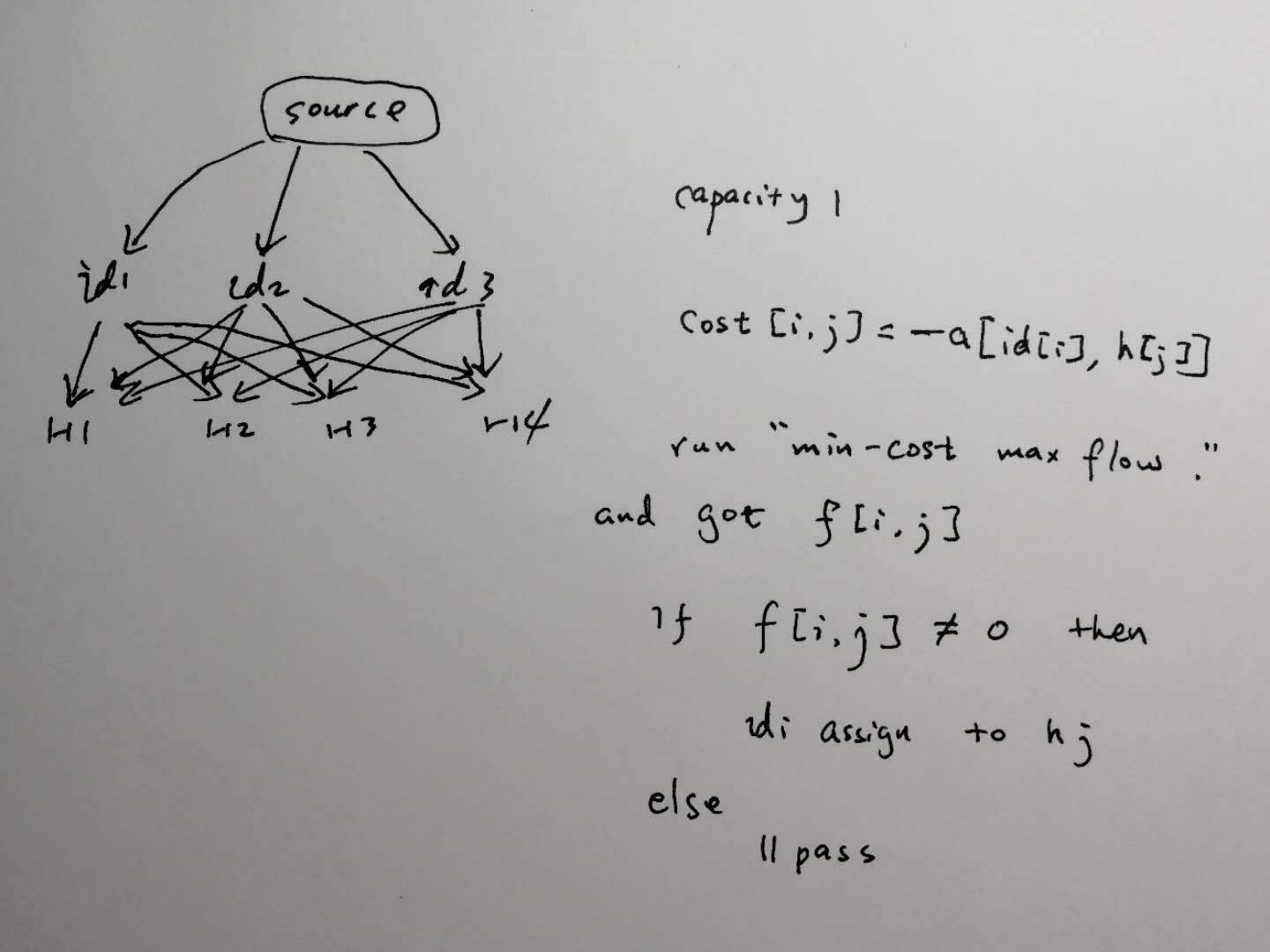min cost max flow算法示例
问题描述
给定g个group,n个id,n<=g.我们将为每个group分配一个id(各个group的id不同)。但是每个group分配id需要付出不同的代价cost,需要求解最优的id分配方案,使得整体cost之和最小。
例子
例如以下4个group,三个id,value矩阵A:
| value | id1 | id2 | id3 |
|---|---|---|---|
| H1 | 4 | 3 | 0 |
| H2 | 1 | 0 | 0 |
| H3 | 2 | 0 | 2 |
| H4 | 3 | 1 | 0 |
id_i分配给H_j的代价\(changing cost[i, j]=\sum(A[j,:])-A[j,i]\)。
例如,如果给H1指定id1,则value=4被保留,但是需要付出changing cost为3.
我们需要为H1-H4分别指定一个id1-id3,id4(新建的id),目标是是的总体的changing cost最小。
例子中最优的分配结果是:
H1 <- id2,
H2 <- New ID,
H3 <- id3,
H4 <- id1,
对应的changing cost=8 (4 + 1 + 2 + 1)。
Min-cost Max flow算法
Use min-cost max flow here
Connect source to all ids with capacity 1, connect each id to each h with capacity 1 and cost= -a[id[i], h[j]] (as you need to find maximums actually), and then connect all hs with sink with capacity 1.
After applying min-cost max flow, you will have flow in those (i, j) where you should assign i-th id to j-th h. New ids for other hs.

因为capacity=1,算法最终结果f[i,j]只可能取值0/1。所以,如果f[i,j]=1,则id_i被分配给h_j.
Here is a possible solution of the problem with some help of [min cost max flow algorithm:
http://web.mit.edu/~ecprice/acm/acm08/MinCostMaxFlow.java https://en.wikipedia.org/wiki/Minimum-cost_flow_problem.
The basic idea is to translate consumer id, group id to vertex of graph, translate our constrains to constrains of MinCostMaxFlow problem.
As for POC, I used the source code from website (web.mit.edu), did some change and checked in the algorithm to trunk.
I added unit test RuleBasedOptimizerTest.test6() to test the 66x 4 case, which runs successfully in milliseconds.
Also, test was done on the data which caused time out before, and this time it is fast.
Steps of the algorithm:
Create the flow network:
- Introduce a source vertex, a sink vertex;
- Each consumerid is a vertex, each groupid is a vertex;
- Connect source to each consumerId, each edge has capacity 1;
- Connect each consumerId to groupId, each edge has capacity 1;
- Connect each groupId to sink, each edge has capacity 1;
- The cost of a(u, v) is from the cost table, but we need to take -1 x frequency.
Calculate max flow of the network, and get the flow matrix.
- If there is flow from cid_i to gid_k then we assign the cid_i to the gid_k;
- If there is no flow to gid_k, then we assign a new id to gid_k.
Algorithm complex
is O(min(|V|^2 * totflow, |V|^3 * totcost)), where |V|=(#groupid + #consumerId + 2).


 浙公网安备 33010602011771号
浙公网安备 33010602011771号